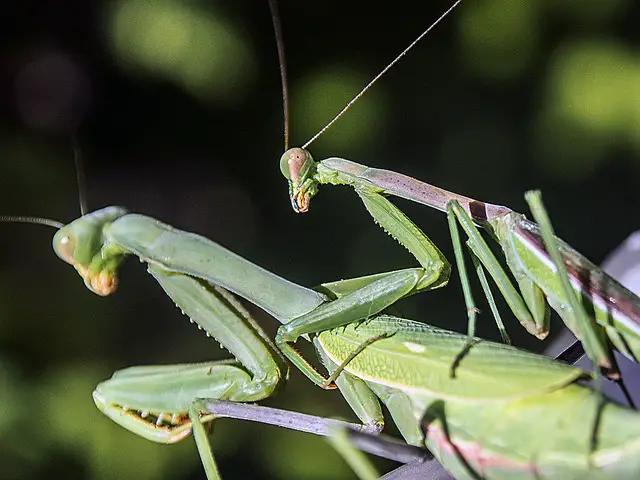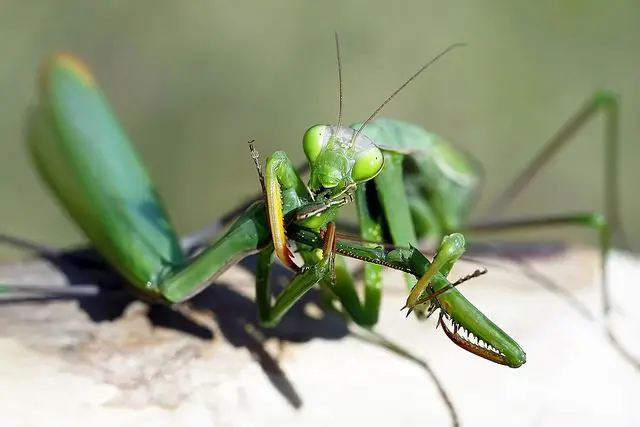While male and female praying mantis share certain characteristics they do have few dissimilarities too. The difference between male and female mantis isn’t so obvious when they are young; it becomes more pronounced with age. You’re more likely to recognize praying mantis male or female when they have reached adulthood. Let’s have a look at each of them and see if they are sexually dimorphic.
Difference Between Male and Female Praying Mantis – Male and Female Praying Mantis
- Difference of Antennae
- Set of Wings and Flying ability
- Counting of Abdomen Segments
- Body Size and Length
- Cannibalism Behavior
1.) Difference of Antennae
The morphology of antennae isn’t so prominent when the mantis is at the growing stage i.e. nymphs. It’s hard to distinguish whether it’s a male or female. However, as they grow older, the male’s antennae do not only grow longer than the female’s it also becomes relatively thicker.
If you take a closer look at a nymph perhaps you’d find the same difference in that the female possesses extremely thin thread-like antennae while the male’s antennae is thicker. Depending on the species, sometimes females have smooth antennae while the male’s antennae are thin hair-like. Smaller mantids have 18 to 20 mm long antennae whereas larger specimens have antennae that measures around 32 to 26mm.
Read More: Why Does the Female Mantis Eat the Male?

2.) Set of Wings and Flying Ability
Although both male and female have wings, it’s only the male that can fly. Males must fly up to their mating partner during breeding season.
Although both male and female have wings, it’s only the male that can fly. Males must fly up to their mating partner during breeding season. Since males fly, their wings are longer than the female’s something that can be observed only when they become adults. The Hierodula transcaucasica female possesses pretty long wings one that can cover all her body.
However the species may be, the male’s wings are either always up to the size of its body or bigger. It is one basic rule of a flight that is the wings must be at least bigger than the body. The female’s wings are just not big enough to lift their heavy weight. The Rivetina baetica female has 19 – 24 mm long wings while the male’s wings measures around 40 – 42 mm in length.
3.) Counting of Abdomen Segments
Prominent among the differences between male and female praying mantis is their abdomen segments. Male has eight abdominal segments while the female has six. Male has all segments almost equal in size but the female’s segments are not. One of the female’s segments especially the last one at the end of her abdomen is probably the biggest.

4.) Body Size and Length
The rule of thumb in praying mantis is that the female is always bigger than the male. The female reaches the overall length of 10 inches while the male measures around 6 to 7 inches. The male has relatively slender body while the females are fatter. Different species have different lengths estimating 96-105 mm, 54-70 mm and 32-38 mm.
5.) Cannibalism Behavior
Apart from structural differences, the male and female praying mantis exhibit different behavioral adaptations. The cannibalism is observed in female praying mantis while the males are almost entirely innocuous. Females likely cannibalize their mating partner right after the copulation. Scientists believe that females are usually too hungry to mate with the male. More so, they will prefer smaller males so they could easily eat them after mating.
Difference Between Male and Female Praying Mantis – Video
References
Kristensen Lepidoptera NP. Moths and Butterflies: Morphology, Physiology, and Development. Arthropoda: Insecta, part 36. Walter de Gruyter, Berlin and New York. 2003; xii-564.
Mohammad SK, Gadalla SM, El-Hamouly H, Ehrmann R, El-Den Nadder MG. Mantodea of Egypt. Zootaxa, 2011; 3044:1-27.
Vollrath F, Parker GA. Sexual Dimorphism and Distorted Sex-Ratios in Spiders. Nature. 1992; 360: 156–159.
Shine R. Ecological Causes for the Evolution of Sexual Dimorphism: A Review of the Evidence. The Quarterly Review of Biology. 1989; 64:419-461
Leave a Reply